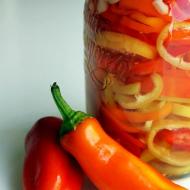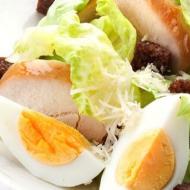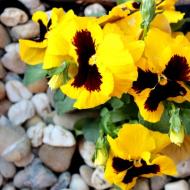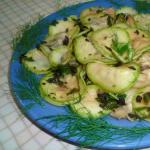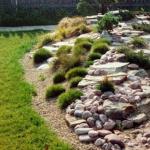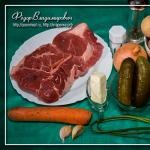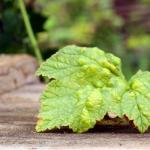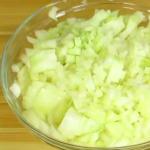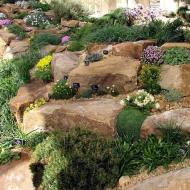
Bordeaux liquid: how to cook and apply
Ravilov Vladimir | 2014-10-06
Bordeaux liquid - a mixture of copper mood and hawed lime, effective fungicide to combat fungal plant diseases in the garden and garden. The article will help properly prepare and apply the drug to get a useful effect, and not damage.
Bordeaux liquid was developed in France, in the second half of the XIX century, in the Bordeaux County (hence the origin of the name - from the name of the area). Initially, fungicide was used to process vineyards against gribkovaya Grape diseases, Mildew, but then the scope of the bordeaux mixture was noticeably expanded.
Now, burglar liquid is used in the fight against the pathogens of mushroom diseases on fruit and berry shrubs, against moniliosis, pasta, spotting.
Bordeaux liquid - CUSO4 · 5H2O copper mulk solution in Lime Milk Ca (OH) 2. Heavenly blue liquid. It is used in crop production as a fungicide. For the first time, the mixture was invented by the French botanist P. Millard (1838-1902) to protect vineyards from the mold mushroom Plasmopara Viticola.
Source: Wikipedia
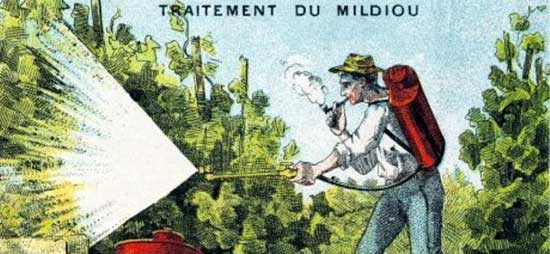
Bordeaux fluid is based on a mixture of aqueous solutions of copper sulfate and lime milk. When preparing a solution, it is very important that the interaction of lime and copper sulfate (sulfate copper) occurred in an alkaline medium. Only in this case, particles of the sulfuric acid of the smallest dimensions are formed, which have amazing activity in the fight against fungi and bacteria - they perfectly stick to the surface of the plants and hold on them for a long time.
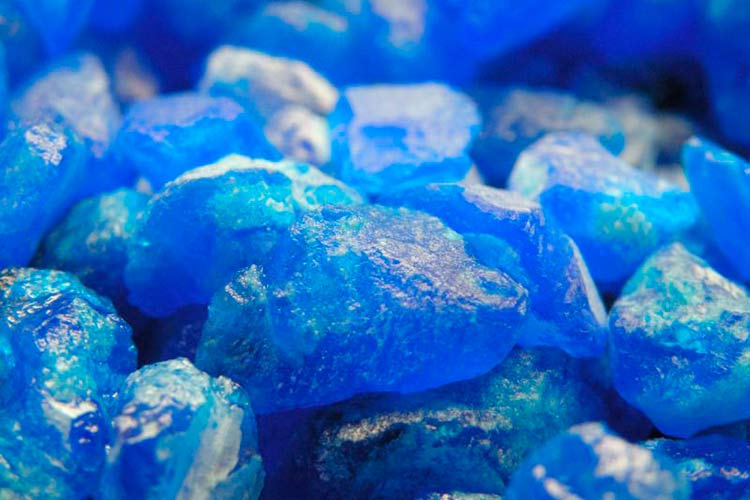
With proper preparation of the solution, a blue, cushy, a precipitate is formed in the burglar fluid that remains for quite a long time in a suspended solution.
Cooking Bordeaux Mixes
To prepare a 1% burgundy mixture (10 liters) you need to take:
- copper vigor - 100 gr.;
- lime Negaren - 100 gr.;
- water - 8 liters.
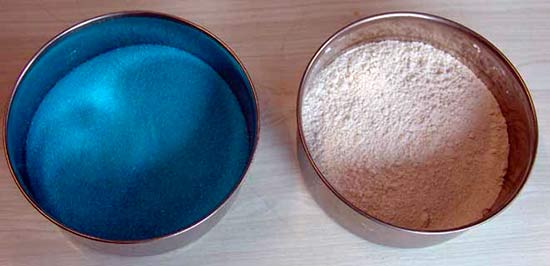 Copper vigorous and lime is the base of borodosky liquids. Photo: www.heritagefrurttrees.com.au.
Copper vigorous and lime is the base of borodosky liquids. Photo: www.heritagefrurttrees.com.au. The components of the bordeaux liquid are bred in different vessels. Copper vigorous is dissolved in 1 l warm water in clay, wooden, copper or glassware. In another dishes, the forgent lime is quenched in 1 liter of water.
To prepare a 3% burglar liquid, you need to take 300 grams of copper vapor and 300-400 grams of negated lime. The amount of water does not change!
After the preparation of both solutions, they are mixed, pouring a solution of copper sulfate into lime milk (not vice versa!) Stirring with a wooden stirrer.
The volume of the resulting solution is adjusted to 10 liters, pouring clean water and constantly stirring.
Precautions
To avoid burns on the leaves, stalks and fruits of plants, the solution reaction must be checked with a lactium paper. We remind you, the lactium paper shines with an alkaline reaction and blushes with acidic.
If the lactium paper has become a blue, then in the bordrian solution of fluid oversupply of lime. Such a liquid has weak fungicidal properties, a precipitate is rapidly formed in it, it is unevenly distributed on the treated surface during processing. When the lime is re-published, the mixture is excessively sticking to leaves and stems.
If the Lacmus blushed, then this is a sign of an oversupply of copper sulfate. Such a solution is toxic for plants and is not recommended for use.
To check the bordeaux fluid reaction without a litmus paper, it is necessary to put a metal object peeled from paint and oxides (for example, a nail or knife blade) into the solution (for example, a nail or knife blade). If a red flask appeared on the metal (copper sulfate), then the bordrian solution was made incorrectly. In excess of copper sulfate on plants, burns are formed, in places of cluster of the solution.
In order to reduce the acidity of the bordeaux fluid solution, it is necessary to add lime milk into it in such a quantity to the steel item lowered to the solution ceased to be covered with copper.
Storage term of burgundy fluid
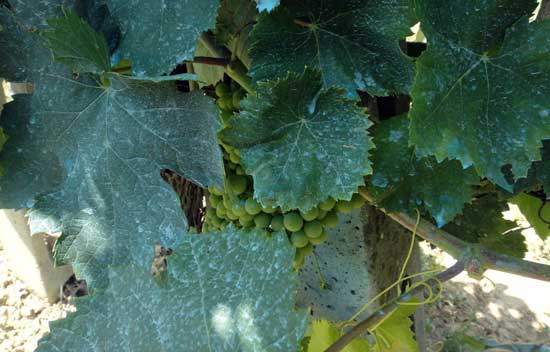
The cooked solution of burglar liquid must be used on the day of preparation. If you postpone the treatment with the finished solution for a couple of days, the beneficial properties of the solution deteriorate greatly - the particles of the fungicide will be bad to stick to the surface of the plants.
During the growing season, the bordeaux fluid can cause burns on the leaves and fruits. The appearance of them on the fruits is accompanied by the formation of a brown mesh. The manifestation of phyto toxicity of the drug is enhanced in rainy and cool weather.
In addition to the grid, brown stains appear on the fruits, on which the peel is cracking, burns for young fruits are especially dangerous. The manifestation of burns on young fruits may be accompanied by their uglyness. Of the fruit crops are most sensitive to boroscopic liquid apricot and a sweet cherry.
Applying burglar fluid
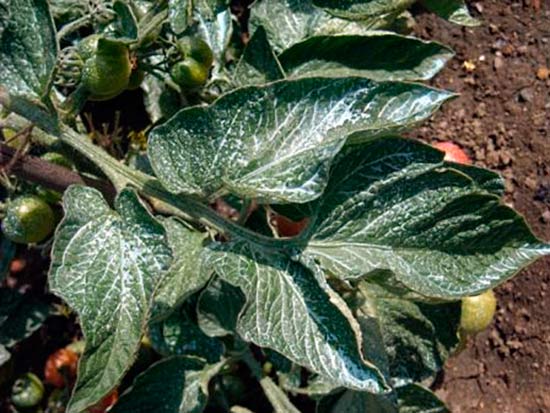 Bordeaux liquid on tomato leaves. Photo: BRGA.CO.UK.
Bordeaux liquid on tomato leaves. Photo: BRGA.CO.UK. The use of burgue fluid before the plant infection with pathogenic organisms is effective as a prophylactic measure. Spray plants evenly over the entire surface of the leaves from the bottom and the upper side with small drops. Do not handle fruit and berry cultures during flowering. Last spraying - 15 days before harvesting.
 The fruit trees can not be treated with a burgundy mixture during flowering, and the rest of the time to six times per season
The fruit trees can not be treated with a burgundy mixture during flowering, and the rest of the time to six times per season Multiplicity of processing bordeaux liquid:
- Vs flash, Moniliosis and Spotted On fruit trees and berry shrubs before breaking or during the dissolution of the kidneys, a bordeaux mixture of 300 grams of copper sulfate is used and 400 grams of lime. During the vegetation, an ordinary one-rise mixture is used, with a periodicity of 15 days.
- On raspberry, strawberry (strawberry) against the spottedness of the leaves during the period of active growth and development Bordeaux liquid apply two, before flowering and after harvesting.
- On pear and apple, against moniliosis, rust, spottedness and browning leaves Bordeaux liquid can be used 6 times For vegetation.
- On cherry and draining against kokkomicosis and swasteporiosis are treated with a burgue mixture 4 times per season.
- On tomatoes (tomatoes) and potatoes Bordeaux liquid is effective against phytoofluorosis and macroship - process 4 times For vegetation.
- On cucumbers and mesh cultures Bordeaux liquid applied against peridosponosis, ascohutosis, anthrax, bacteriosis and olive spottedness 3 times during the summer.
- Treatment of Luca Bordeaux fluid solves problems with peronosporosis, rust and rot. It is impossible to handle the onions grown on the feather. Luke Treatment Multipliament 3 times per season.
- On currant and gooseberry Bordeaux mixture applied against septoriasis and anthraznosis 3 times per season.
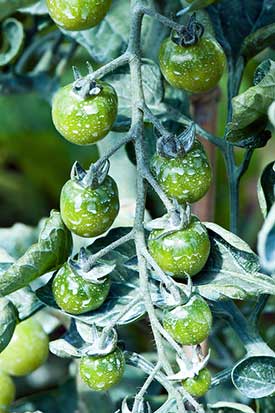
Attention! In all cases, in addition to processing fruit-berry shrubs before the renal dissolve is used 1% Bordeaux Mix!
Bordeaux liquid can be mixed only with sulfur-containing drugs. Before refueling the sprayer tank, the liquid is well mixed.
The fungicidal effect of the mixing preparation is due to the separation of the sulfuric acid of copper formed during the hydrolysis of the main salt of the sulfuric acid of copper under the influence of air carbon dioxide of mushrooms and plants. High humidity and temperature accelerate this process, reducing the defense period of the fungicide.
According to the results of studies, high efficiency against pasta, fruit rot, the swasteporosis shows a 3-4% burglar liquid applied in early spring (in the fenofhaze "swelling" or the "beginning of a kidney dissolution").
The reserve of copper after the "blue" spraying is enough for a month to protect trees from pathogens of fungal diseases. In addition to the "blue" spraying, during the growing season, 2-3 treatments with 1% burglar fluid at intervals of 7-15 days are carried out.


